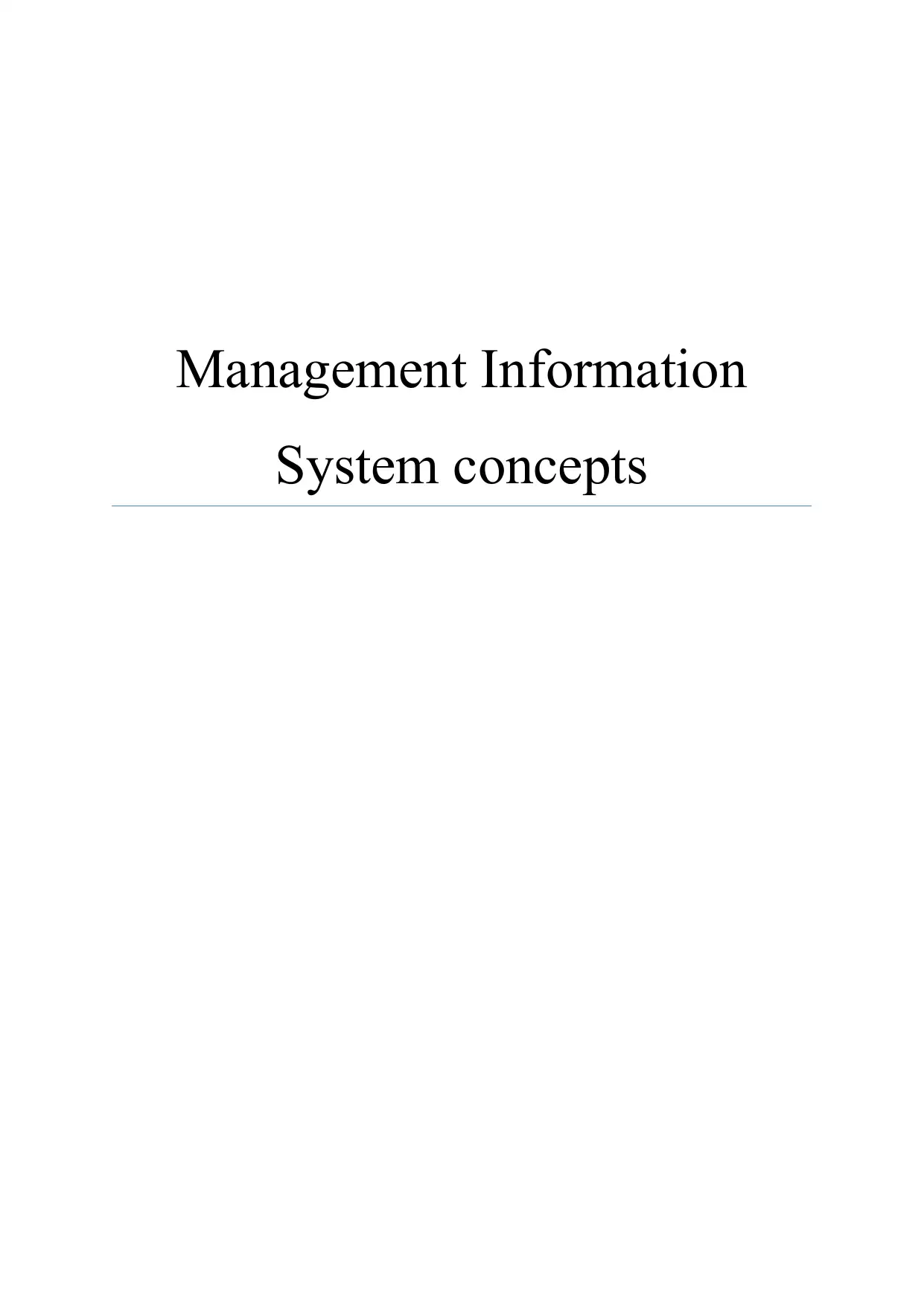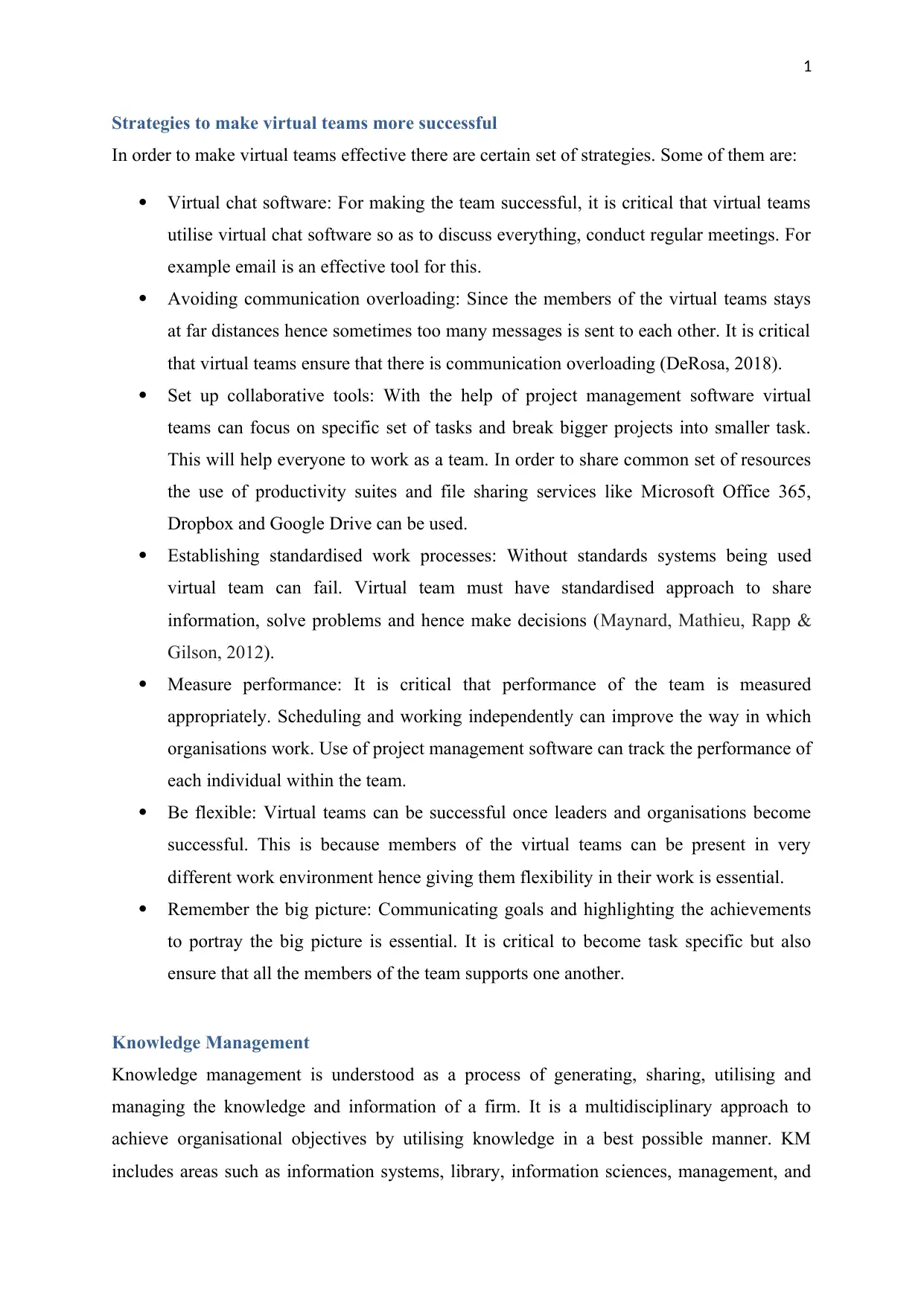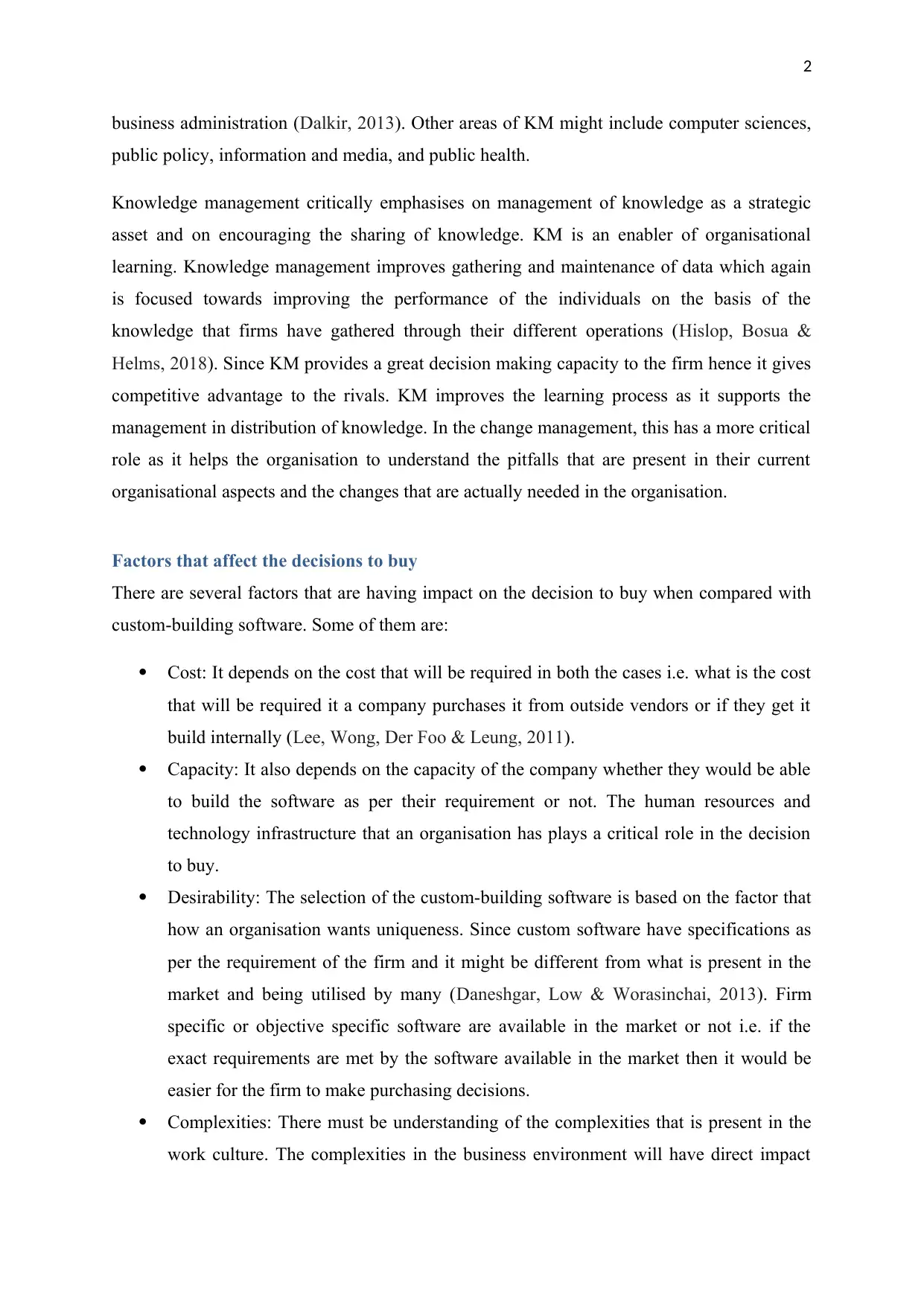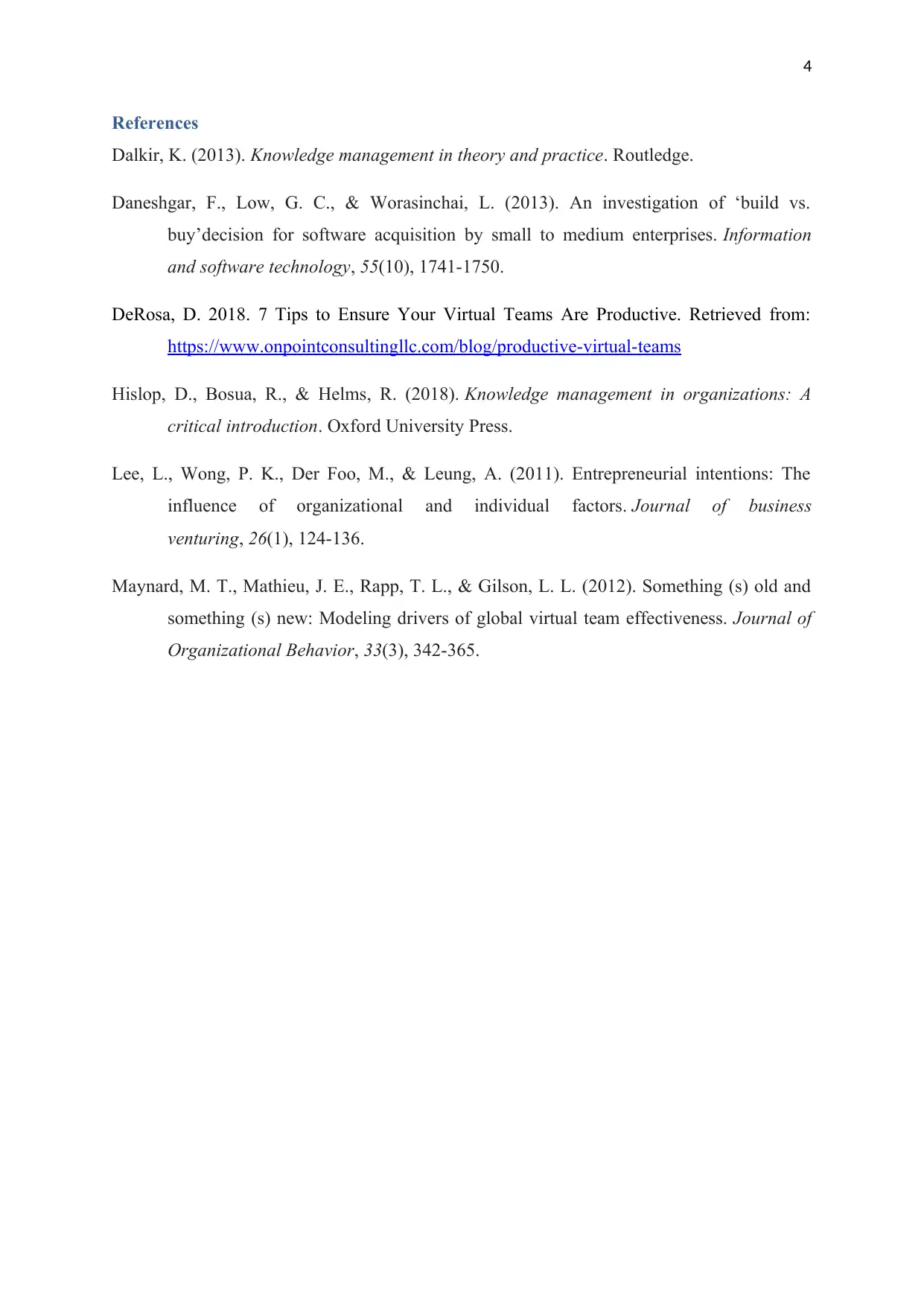MIS Assignment: Strategies for Virtual Teams & Knowledge Management
VerifiedAdded on 2022/10/06
|5
|1080
|312
Report
AI Summary
This report delves into crucial Management Information System (MIS) concepts. It begins by outlining effective strategies for successful virtual teams, emphasizing virtual chat software, avoiding communication overload, setting up collaborative tools, establishing standardized work processes, measuring performance, flexibility, and maintaining a big-picture perspective. The report then explores knowledge management (KM), defining it as the process of generating, sharing, and utilizing organizational knowledge to achieve objectives, highlighting its role in decision-making, competitive advantage, and organizational learning. Finally, the report examines the factors influencing the decision to buy software versus custom-building, including cost, capacity, desirability, and complexities, providing a comprehensive overview of these critical MIS elements and their impact on business operations.

Management Information
System concepts
System concepts
Paraphrase This Document
Need a fresh take? Get an instant paraphrase of this document with our AI Paraphraser

1
Strategies to make virtual teams more successful
In order to make virtual teams effective there are certain set of strategies. Some of them are:
Virtual chat software: For making the team successful, it is critical that virtual teams
utilise virtual chat software so as to discuss everything, conduct regular meetings. For
example email is an effective tool for this.
Avoiding communication overloading: Since the members of the virtual teams stays
at far distances hence sometimes too many messages is sent to each other. It is critical
that virtual teams ensure that there is communication overloading (DeRosa, 2018).
Set up collaborative tools: With the help of project management software virtual
teams can focus on specific set of tasks and break bigger projects into smaller task.
This will help everyone to work as a team. In order to share common set of resources
the use of productivity suites and file sharing services like Microsoft Office 365,
Dropbox and Google Drive can be used.
Establishing standardised work processes: Without standards systems being used
virtual team can fail. Virtual team must have standardised approach to share
information, solve problems and hence make decisions (Maynard, Mathieu, Rapp &
Gilson, 2012).
Measure performance: It is critical that performance of the team is measured
appropriately. Scheduling and working independently can improve the way in which
organisations work. Use of project management software can track the performance of
each individual within the team.
Be flexible: Virtual teams can be successful once leaders and organisations become
successful. This is because members of the virtual teams can be present in very
different work environment hence giving them flexibility in their work is essential.
Remember the big picture: Communicating goals and highlighting the achievements
to portray the big picture is essential. It is critical to become task specific but also
ensure that all the members of the team supports one another.
Knowledge Management
Knowledge management is understood as a process of generating, sharing, utilising and
managing the knowledge and information of a firm. It is a multidisciplinary approach to
achieve organisational objectives by utilising knowledge in a best possible manner. KM
includes areas such as information systems, library, information sciences, management, and
Strategies to make virtual teams more successful
In order to make virtual teams effective there are certain set of strategies. Some of them are:
Virtual chat software: For making the team successful, it is critical that virtual teams
utilise virtual chat software so as to discuss everything, conduct regular meetings. For
example email is an effective tool for this.
Avoiding communication overloading: Since the members of the virtual teams stays
at far distances hence sometimes too many messages is sent to each other. It is critical
that virtual teams ensure that there is communication overloading (DeRosa, 2018).
Set up collaborative tools: With the help of project management software virtual
teams can focus on specific set of tasks and break bigger projects into smaller task.
This will help everyone to work as a team. In order to share common set of resources
the use of productivity suites and file sharing services like Microsoft Office 365,
Dropbox and Google Drive can be used.
Establishing standardised work processes: Without standards systems being used
virtual team can fail. Virtual team must have standardised approach to share
information, solve problems and hence make decisions (Maynard, Mathieu, Rapp &
Gilson, 2012).
Measure performance: It is critical that performance of the team is measured
appropriately. Scheduling and working independently can improve the way in which
organisations work. Use of project management software can track the performance of
each individual within the team.
Be flexible: Virtual teams can be successful once leaders and organisations become
successful. This is because members of the virtual teams can be present in very
different work environment hence giving them flexibility in their work is essential.
Remember the big picture: Communicating goals and highlighting the achievements
to portray the big picture is essential. It is critical to become task specific but also
ensure that all the members of the team supports one another.
Knowledge Management
Knowledge management is understood as a process of generating, sharing, utilising and
managing the knowledge and information of a firm. It is a multidisciplinary approach to
achieve organisational objectives by utilising knowledge in a best possible manner. KM
includes areas such as information systems, library, information sciences, management, and

2
business administration (Dalkir, 2013). Other areas of KM might include computer sciences,
public policy, information and media, and public health.
Knowledge management critically emphasises on management of knowledge as a strategic
asset and on encouraging the sharing of knowledge. KM is an enabler of organisational
learning. Knowledge management improves gathering and maintenance of data which again
is focused towards improving the performance of the individuals on the basis of the
knowledge that firms have gathered through their different operations (Hislop, Bosua &
Helms, 2018). Since KM provides a great decision making capacity to the firm hence it gives
competitive advantage to the rivals. KM improves the learning process as it supports the
management in distribution of knowledge. In the change management, this has a more critical
role as it helps the organisation to understand the pitfalls that are present in their current
organisational aspects and the changes that are actually needed in the organisation.
Factors that affect the decisions to buy
There are several factors that are having impact on the decision to buy when compared with
custom-building software. Some of them are:
Cost: It depends on the cost that will be required in both the cases i.e. what is the cost
that will be required it a company purchases it from outside vendors or if they get it
build internally (Lee, Wong, Der Foo & Leung, 2011).
Capacity: It also depends on the capacity of the company whether they would be able
to build the software as per their requirement or not. The human resources and
technology infrastructure that an organisation has plays a critical role in the decision
to buy.
Desirability: The selection of the custom-building software is based on the factor that
how an organisation wants uniqueness. Since custom software have specifications as
per the requirement of the firm and it might be different from what is present in the
market and being utilised by many (Daneshgar, Low & Worasinchai, 2013). Firm
specific or objective specific software are available in the market or not i.e. if the
exact requirements are met by the software available in the market then it would be
easier for the firm to make purchasing decisions.
Complexities: There must be understanding of the complexities that is present in the
work culture. The complexities in the business environment will have direct impact
business administration (Dalkir, 2013). Other areas of KM might include computer sciences,
public policy, information and media, and public health.
Knowledge management critically emphasises on management of knowledge as a strategic
asset and on encouraging the sharing of knowledge. KM is an enabler of organisational
learning. Knowledge management improves gathering and maintenance of data which again
is focused towards improving the performance of the individuals on the basis of the
knowledge that firms have gathered through their different operations (Hislop, Bosua &
Helms, 2018). Since KM provides a great decision making capacity to the firm hence it gives
competitive advantage to the rivals. KM improves the learning process as it supports the
management in distribution of knowledge. In the change management, this has a more critical
role as it helps the organisation to understand the pitfalls that are present in their current
organisational aspects and the changes that are actually needed in the organisation.
Factors that affect the decisions to buy
There are several factors that are having impact on the decision to buy when compared with
custom-building software. Some of them are:
Cost: It depends on the cost that will be required in both the cases i.e. what is the cost
that will be required it a company purchases it from outside vendors or if they get it
build internally (Lee, Wong, Der Foo & Leung, 2011).
Capacity: It also depends on the capacity of the company whether they would be able
to build the software as per their requirement or not. The human resources and
technology infrastructure that an organisation has plays a critical role in the decision
to buy.
Desirability: The selection of the custom-building software is based on the factor that
how an organisation wants uniqueness. Since custom software have specifications as
per the requirement of the firm and it might be different from what is present in the
market and being utilised by many (Daneshgar, Low & Worasinchai, 2013). Firm
specific or objective specific software are available in the market or not i.e. if the
exact requirements are met by the software available in the market then it would be
easier for the firm to make purchasing decisions.
Complexities: There must be understanding of the complexities that is present in the
work culture. The complexities in the business environment will have direct impact
⊘ This is a preview!⊘
Do you want full access?
Subscribe today to unlock all pages.

Trusted by 1+ million students worldwide

3
on the decisions made by the organisations. These complexities are also understood in
terms of the designing of the software.
on the decisions made by the organisations. These complexities are also understood in
terms of the designing of the software.
Paraphrase This Document
Need a fresh take? Get an instant paraphrase of this document with our AI Paraphraser

4
References
Dalkir, K. (2013). Knowledge management in theory and practice. Routledge.
Daneshgar, F., Low, G. C., & Worasinchai, L. (2013). An investigation of ‘build vs.
buy’decision for software acquisition by small to medium enterprises. Information
and software technology, 55(10), 1741-1750.
DeRosa, D. 2018. 7 Tips to Ensure Your Virtual Teams Are Productive. Retrieved from:
https://www.onpointconsultingllc.com/blog/productive-virtual-teams
Hislop, D., Bosua, R., & Helms, R. (2018). Knowledge management in organizations: A
critical introduction. Oxford University Press.
Lee, L., Wong, P. K., Der Foo, M., & Leung, A. (2011). Entrepreneurial intentions: The
influence of organizational and individual factors. Journal of business
venturing, 26(1), 124-136.
Maynard, M. T., Mathieu, J. E., Rapp, T. L., & Gilson, L. L. (2012). Something (s) old and
something (s) new: Modeling drivers of global virtual team effectiveness. Journal of
Organizational Behavior, 33(3), 342-365.
References
Dalkir, K. (2013). Knowledge management in theory and practice. Routledge.
Daneshgar, F., Low, G. C., & Worasinchai, L. (2013). An investigation of ‘build vs.
buy’decision for software acquisition by small to medium enterprises. Information
and software technology, 55(10), 1741-1750.
DeRosa, D. 2018. 7 Tips to Ensure Your Virtual Teams Are Productive. Retrieved from:
https://www.onpointconsultingllc.com/blog/productive-virtual-teams
Hislop, D., Bosua, R., & Helms, R. (2018). Knowledge management in organizations: A
critical introduction. Oxford University Press.
Lee, L., Wong, P. K., Der Foo, M., & Leung, A. (2011). Entrepreneurial intentions: The
influence of organizational and individual factors. Journal of business
venturing, 26(1), 124-136.
Maynard, M. T., Mathieu, J. E., Rapp, T. L., & Gilson, L. L. (2012). Something (s) old and
something (s) new: Modeling drivers of global virtual team effectiveness. Journal of
Organizational Behavior, 33(3), 342-365.
1 out of 5
Related Documents
Your All-in-One AI-Powered Toolkit for Academic Success.
+13062052269
info@desklib.com
Available 24*7 on WhatsApp / Email
![[object Object]](/_next/static/media/star-bottom.7253800d.svg)
Unlock your academic potential
Copyright © 2020–2025 A2Z Services. All Rights Reserved. Developed and managed by ZUCOL.




